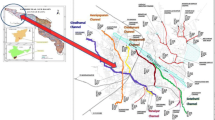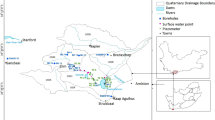Abstract
Hydrogeochemical characteristics of groundwater and its suitability for domestic, irrigation, and industrial purposes were evaluated in Nanded Tehsil. A total of 50 representative groundwater samples were collected from dug/bore wells during post monsoon season 2012 and analyzed for major cations and anions. The order of dominance of cation and anions were Na > Ca > Mg > K and HCO3 > Cl > CO3 > SO4 > NO3, respectively. The rock weathering and evaporation processes are dominant in controlling the groundwater quality in the study area. Electrical conductivity (EC) and total dissolved solid (TDS) show high positive correlation with total Hardness (TH), Ca, Na, and Cl. As per the WHO and BIS standards for domestic water purposes, TDS, TH, Ca, Mg, Na, and Cl exceed the safe limits in 16, 22, 6, 18, 12, and 15 %, respectively; therefore, majority of samples show that the groundwater is suitable for drinking. The spatial distribution maps of physicochemical parameters were prepared in ArcGIS. The suitability of groundwater for agriculture purpose was evaluated from EC, TDS, sodium adsorption ratio (SAR), residual sodium carbonate (RSC), and %Na which ranges from excellent to unsuitable, so majority of the groundwater samples are suitable for irrigation. The U.S. Salinity Laboratory (USSL) diagram shows that most of the groundwater samples are characterized as in high salinity-low sodium hazard type water (C3-S1). All the groundwater samples are suitable for industrial use except sample numbers 44 and 48. Thus, most of the groundwater samples from this study confirm the beneficial use of aquifers in the area for domestic, agricultural, and irrigation purposes. However, sample numbers 44 and 48 identify the two aquifers in the study area which are problematic and need particular remedial measures if they are to have beneficial use.







Similar content being viewed by others
References
Ahamed AJ, Ananthakrishnan S, Loganathan K, Manikandan K (2013) Assessment of groundwater quality for irrigation use in Alathur Block, Perambalur District, Tamilnadu, South India. Appl Water Sci 3(4):763–771
Al-Ahmadi ME (2013) Hydrochemical characterization of groundwater in wadi Sayyah, Western Saudi Arabia. Appl Water Sci 3(4):721–732
American Public Health Association (APHA) (1995) Water environment federation. Standard methods for the examination of water and wastewater 19
ANON (1983) Groundwater and Wells. Johnson Division, 1st Ed., Jain brothers. 450 p
Ayers RS, & Westcot DW (1994) Water quality for agriculture. Rome: FAO,. 174p. FAO. Irrigation and Drainage Paper, 29
BIS (2003) Bureau of Indian Standard specification for drinking water; IS:10500:91. Revised 2003. Bureau of Indian Standard, New Delhi
Burrough PA, McDonnell RA (1998) Creating continuous surfaces from point data. Principles of geographic information systems. Oxford University Press, Oxford
Central Groundwater Board (CGWB) (2013) Groundwater information Nanded district Maharashtra, Ministry of Water Resources, Govt. of India. Nagpur, p 294
Chandramouli C, & General R (2011) Census of India 2011
Davis SN, Dewiest RJM (1966) Hydrogeology. John Wiley and Sons, New York, p. 463
Doneen LD (1962) The influence of crop and soil on percolating water. InProc. 1961 Biennial conference on groundwater recharge (pp. 156–163)
Foster, S. (1998) Groundwater: assessing vulnerability and promoting protection of a threatened resource. Stockholm water symposium
Freeze RA, Cherry JA (1979) Groundwater., 1979. Printice-Hall Inc, Englewood Cliffs
Gibbs RJ (1970) Mechanisms controlling world water chemistry. Science 170(3962):1088–1090
Goyal SK, Chaudhary BS, Singh O, Sethi GK, Thakur PK (2010) GIS based spatial distribution mapping and suitability evaluation of groundwater quality for domestic and agricultural purpose in Kaithal district, Haryana state, India. Environ Earth Sci 61(8):1587–1597
Hem JD (1985) Study and interpretation of the chemical characteristics of natural water (Vol. 2254). Department of the Interior, US Geological Survey
Jeevanandam M, Kannan R, Srinivasalu S, Rammohan V (2007) Hydrogeochemistry and groundwater quality assessment of lower part of the Ponnaiyar River Basin, Cuddalore district, South India. Environ Monit Assess 132(1–3):263–274
Kelley WP (1963) Use of saline irrigation water. Soil Sci 95(6):385–391
Kirda, C. (1997) Assessment of irrigation water quality. Options Mediterraneennes. Serie A: Seminaires Mediterraneens (CIHEAM)
Kumar M, Ramanathan AL, Rao MS, Kumar B (2006) Identification and evaluation of hydrogeochemical processes in the groundwater environment of Delhi, India. Environ Geol 50(7):1025–1039
Laurent M, François A, & Marie MJ (2010) Assessment of groundwater quality during dry season in Southeastern Brazzaville, Congo
Mukate SV, Panaskar DB, Wagh VM, Pawar RS (2015) Groundwater quality assessment for drinking and irrigation purpose: a case study of Chincholikati MIDC area, Solapur (MS). India srtmu’s Res J Sci 4(1):58–72
Mukherjee S, Kumar BA, Koertvelyessy L (2005) Assessment of groundwater quality, South 24-Parganas, West Bengal coast. India J Environ Hydrol 13
Nash H, & McCall GJH (1995) Groundwater quality. In Groundwater quality. Chapman & Hall Ltd.
Obiefuna GI, Sheriff A (2011) Assessment of shallow ground water quality of Pindiga Gombe Area, Yola Area, NE, Nigeria for irrigation and domestic purposes. Res J Environ Earth Sci 3(2):131–141
Palaniswami C, Ramulu US (1994) Effects of continuous irrigation with paper factory effluent on soil properties. J Indian Soc Soil Sci 42(1):139–140
Piper AM (1944) A graphic procedure in the geochemical interpretation of water-analyses. Eos, Trans Amer Geophys Union 25(6):914–928
Prasanth SS, Magesh NS, Jitheshlal KV, Chandrasekar N, Gangadhar K (2012) Evaluation of groundwater quality and its suitability for drinking and agricultural use in the coastal stretch of Alappuzha District, Kerala, India. Appl Water Sci 2(3):165–175
Raghunath HM (1987) Ground water. New Age International, New Delhi
Rai SN, Thiagarajan S, Kumari YR (2011) Exploration for groundwater in the basaltic Deccan traps terrain in Katol Taluk, Nagpur District, India. Curr Sci 101(9):1198–1205
Ramakrishnan S (1998) Groundwater. Ramakrishnan, Chennai
Ramamurthy K, https://cultural.maharashtra.gov.in/english/gazetteer/Nanded/geo.html
Rao PN, Rao SA, Rao NS (2015) Suitability of groundwater quality for drinking, irrigation and industrial purposes in the Western Delta region of the river Godavari, Andhra Pradesh. J Geol Soc India 86(2):181–190
Richards LA (1954) Diagnosis and improvement of saline and alkali soils. Soil Sci 78(2):154
Sadashivaiah C, Ramakrishnaiah CR, Ranganna G (2008) Hydrochemical analysis and evaluation of groundwater quality in Tumkur Taluk, Karnataka State, India. Int J Environ Res Public Health 5(3):158–164
Sawyer CN, & McCarty PL (1967) Chemistry for sanitary engineers. InChemistry for sanitary engineers. McGraw-Hill
Schoeller H (1965) Qualitative evaluation of groundwater resources. Methods and techniques of groundwater investigations and development. UNESCO
Schoeller H (1967) Methods and techniques of groundwater investigation and development. Water Resour Ser 33
Singh V, Singh UC (2008) Assessment of groundwater quality of parts of Gwalior (India) for agricultural purposes. Ind J Sci Technol 1(4):1–5
Stuyfzand PJ (1989) A new hydrochemical classification of water types. IAHS Publ 182:89–98
Subramani T, Elango L, Damodarasamy SR (2005) Groundwater quality and its suitability for drinking and agricultural use in Chithar River basin, Tamil Nadu, India. Environ Geol 47(8):1099–1110
Todd DK (1980) Groundwater hydrology, 2 edn; New York Wiley
Tóth J (1999) Groundwater as a geologic agent: an overview of the causes, processes, and manifestations. Hydrogeol J 7:11–14
U. S. Salinity Laboratory (USSL) (1954) Diagnosis and improvement of saline and alkaline soil; USSA handbook No. 60. Pp. 160
UCCC (University of California Committee of Consultants) (1974) Guidelines for interpretations of water quality for irrigation. University of California Committee of Consultants, Berkeley
Varade AM, Yenkie RO, Kodate J (2013) Assessment of water quality in and around Hingna area of Nagpur District, Maharashtra for irrigational purposes. J Appl Geochem 15(4):488
Wadia DN (1983) Geology of India and Burma. Revised Edition
WHO (2004) Guidelines for drinking-water quality: recommendations. Vol.1. World Health Organization
Acknowledgment
The authors are thankful to Swami Ramanand Teerth Marathwada University, Nanded for funding this research under Minor Research Project. The authors wish to thank to anonymous reviewers for their valuable suggestions and comments.
Author information
Authors and Affiliations
Corresponding author
Rights and permissions
About this article
Cite this article
Panaskar, D.B., Wagh, V.M., Muley, A.A. et al. Evaluating groundwater suitability for the domestic, irrigation, and industrial purposes in Nanded Tehsil, Maharashtra, India, using GIS and statistics. Arab J Geosci 9, 615 (2016). https://doi.org/10.1007/s12517-016-2641-1
Received:
Accepted:
Published:
DOI: https://doi.org/10.1007/s12517-016-2641-1




